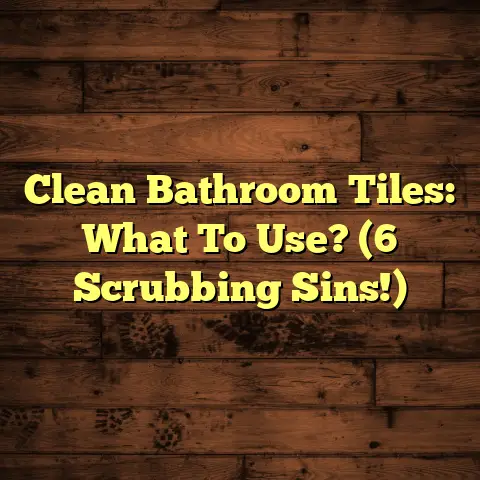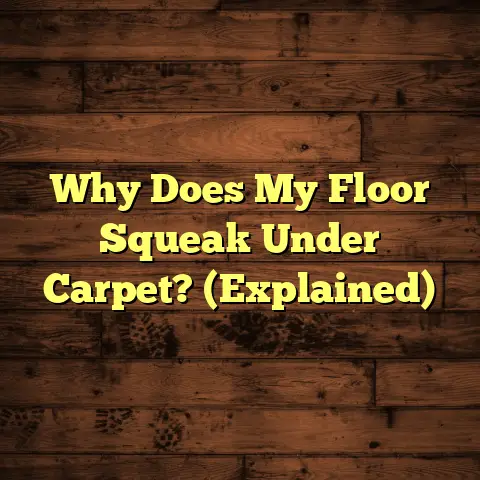Water Through Concrete Slab? (1 Call Could Save It!)
Ever walked into your basement and felt that unmistakable dampness?
Or noticed a funky smell that just won’t go away?
Water sneaking through your concrete slab is a serious red flag, and trust me, ignoring it is like inviting a whole host of problems into your home.
But don’t panic!
Before you start envisioning a complete foundation rebuild, let’s talk about some quick fixes.
Think of grabbing a heavy-duty tarp to cover a persistently wet area outside or slapping on some temporary waterproof sealant to buy you time.
These are Band-Aids, not cures, but they can prevent further damage while you figure out a long-term solution.
Ready to dive in?
Let’s get started!
Section 1: Understanding the Problem
Okay, so what exactly is a concrete slab?
In simple terms, it’s a large, poured concrete foundation that serves as the base for many homes and commercial buildings.
Think of it as the unsung hero holding everything up.
Now, how does water get in?
It’s usually one of a few culprits:
- Groundwater: The water table is high, and the slab isn’t properly sealed.
- Rainwater: Poor drainage around your foundation can cause water to pool and seep through.
- Plumbing Leaks: A hidden pipe leak under the slab can wreak havoc over time.
I’ve seen it all!
One time, a client had a slow leak in their kitchen sink drainpipe that ran under the slab.
They didn’t notice it for months until mold started growing in their carpet.
Yikes!
But what’s the big deal with water damage anyway?
Well, here’s the lowdown:
- Structural Integrity: Water can weaken the concrete, leading to cracks and even foundation settlement.
- Mold Growth: Damp environments are mold’s best friend. Mold can trigger allergies, asthma, and other health issues. According to the CDC, mold exposure can lead to a variety of health problems.
- Health Hazards: Besides mold, water can also attract pests and create unsanitary conditions.
Section 2: Identifying Signs of Water Infiltration
Alright, let’s play detective.
Here are some telltale signs that water is making its way through your concrete slab:
- Damp Spots on Floors: This is the most obvious sign. Look for discoloration or wet patches, especially after rain.
- Mold or Mildew Growth: Check along baseboards, in corners, and under carpets. That musty smell is a dead giveaway.
- Cracks in the Concrete Surface: Even hairline cracks can allow water to seep through.
- Increased Humidity Levels in the Space: A consistently damp feeling in the air, even when it’s not raining, can indicate water infiltration.
I remember one inspection where the homeowner insisted there was no water problem.
But when I pulled back the carpet in the corner of the basement, I found a thriving colony of mold.
The carpet felt slightly damp to the touch, and there was a clear water stain on the concrete underneath.
Don’t underestimate the power of a good sniff test either!
Section 3: Short-Term Solutions
Okay, you’ve spotted some warning signs.
What can you do right now to mitigate the damage?
- Temporary Waterproofing Solutions: Apply a concrete sealer to the affected area. These sealers create a barrier that prevents water from penetrating the surface.
- Dehumidifiers: Crank up the dehumidifier to reduce humidity levels and discourage mold growth.
- Tarping Outdoor Areas: If the water is coming from rain, cover the affected area with a tarp to prevent further accumulation.
These are temporary fixes, remember?
Think of them as first aid.
They’ll buy you some time, but you’ll need to address the underlying problem to prevent it from recurring.
It’s like putting a bandage on a broken leg – it might stop the bleeding, but it won’t fix the bone!
Section 4: Long-Term Solutions
Now, let’s get serious about fixing this problem for good.
Here are some comprehensive solutions:
- Professional Assessment: The first step is to call a foundation expert or waterproofing specialist. They can diagnose the source of the water and recommend the best course of action.
- Excavation and Drainage Systems:
- French Drains: These are perforated pipes buried around the foundation to collect and redirect water.
- Sump Pumps: These pumps automatically remove water that accumulates in a sump pit, preventing it from flooding your basement.
- Grading: Proper grading ensures that water flows away from your foundation, not towards it.
- Interior Repairs:
- Epoxy Injections for Cracks: Epoxy injections can seal cracks in the concrete, preventing water from seeping through.
- Sealing Methods: Applying a waterproof membrane to the interior walls can create a barrier against moisture.
- Floor Coverings: Choose moisture-resistant flooring options, such as tile or epoxy coatings.
- Exterior Solutions:
- Landscaping: Plant trees and shrubs away from the foundation to prevent roots from damaging the concrete.
- Gutters and Downspouts: Ensure that gutters and downspouts are properly installed and maintained to divert water away from the foundation.
I had a client with a seriously leaky basement.
We ended up installing a French drain system, a sump pump, and re-grading their yard.
It was a big project, but it completely solved the problem.
They haven’t had a drop of water in their basement since!
According to the American Society of Civil Engineers (ASCE), proper drainage systems can extend the life of a foundation by up to 50 years.
Section 5: When to Call a Professional
Okay, let’s be honest.
Some of these solutions are not DIY-friendly.
Here are some scenarios where you should definitely call a professional:
- Extensive Water Damage or Visible Mold: If you’re dealing with a significant amount of water or mold, it’s best to leave it to the experts.
- Large Cracks or Structural Issues in the Slab: These problems require specialized knowledge and equipment.
- Persistent Water Problems That Do Not Respond to Quick Fixes: If you’ve tried everything and the water keeps coming back, it’s time to call in the cavalry.
How do you choose a qualified contractor?
- Get Recommendations: Ask friends, family, or neighbors for referrals.
- Check Online Reviews: See what other people have to say about their experience with the contractor.
- Verify Licensing and Insurance: Make sure the contractor is licensed and insured to protect yourself from liability.
- Get Multiple Bids: Compare bids from different contractors to ensure you’re getting a fair price.
- Ask Questions: Don’t be afraid to ask the contractor about their experience, qualifications, and approach to the project.
Section 6: Preventative Measures
The best way to deal with water infiltration is to prevent it from happening in the first place.
Here are some preventative measures you can take:
- Regular Maintenance Checks for Plumbing and Drainage Systems: Inspect your pipes and drains regularly for leaks or clogs.
- Proper Landscaping and Grading Around the Property: Ensure that your yard slopes away from your foundation to prevent water from pooling.
- Installing Vapor Barriers During Construction or Renovation: Vapor barriers can prevent moisture from seeping through the concrete slab.
I always tell my clients that preventative maintenance is the key to avoiding costly repairs down the road.
It’s like changing the oil in your car – it’s a small investment that can save you from major engine problems later.
According to the National Association of Home Builders (NAHB), preventative maintenance can save homeowners thousands of dollars over the lifespan of their homes.
Conclusion
So, there you have it!
Water infiltration through concrete slabs is a serious problem, but it’s one that can be solved with the right knowledge and approach.
Remember, acting quickly is crucial.
Whether you implement temporary fixes or call in the pros for long-term solutions, don’t delay.
That one call could save you a whole lot of time, money, and stress in the long run.
Don’t let a little water turn into a major headache.
Take action now and protect your home from the damaging effects of water infiltration!





